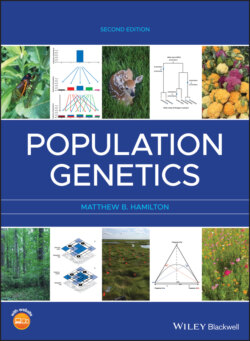Читать книгу Population Genetics - Matthew B. Hamilton - Страница 49
Mating system
ОглавлениеAs covered earlier in this chapter, self‐fertilization and mating between relatives increase homozygosity at the expense of heterozygosity. An increase in homozygosity causes a reduction in the effective rate of recombination because crossing over between two homozygous loci does not alter the gamete haplotypes produced by that genotype. The effective recombination fraction under self‐fertilization is
(2.39)
where s is the proportion of progeny produced by self‐fertilization each generation. This is based on the expected fixation index at equilibrium (Haldane 1924; see Figure 2.13). Figure 2.22 shows the decay in gametic disequilibrium predicted by Eq. 2.39 for four self‐fertilization rates in the cases of free recombination (c = 0.5) and well as tight linkage (c = 0.05). Self‐fertilization clearly increases the persistence of gametic disequilibrium, with marked effects at high selfing rates. In fact, the predominantly self‐fertilizing plant Arabidopsis thaliana exhibits gametic disequilibrium over much longer regions of chromosome compared to outcrossing plants and animals (see review by Flint‐Garcia et al. 2003, Kim et al. 2007).
Table 2.13 Example of the effect of population admixture on gametic disequilibrium. In this case, the two populations are each at gametic equilibrium given their respective allele frequencies. When an equal number of gametes from each of these two genetically diverged populations are combined to form a new population, gametic disequilibrium results from the diverged gamete frequencies in the founding populations. The allele frequencies are: population 1 p1 = 0.1, p2 = 0.9, q1 = 0.1, q2 = 0.9; population 2 p1 = 0.9, p2 = 0.1, q1 = 0.9, q2 = 0.1. In population 1 and population 2, gamete frequencies are the product of their respective allele frequencies as expected under independent segregation. In the mixture population, all allele frequencies become the average of the two source populations (0.5) with Dmax = 0.25.
| Gamete | Gamete frequency | Population 1 | Population 2 | Mixture population | |
|---|---|---|---|---|---|
| A1B1 | g 11 | 0.01 | 0.81 | 0.41 | |
| A2B2 | g 22 | 0.81 | 0.01 | 0.41 | |
| A1B2 | g 12 | 0.09 | 0.09 | 0.09 | |
| A2B1 | g 21 | 0.09 | 0.09 | 0.09 | |
| D | 0.0 | 0.0 | 0.16 | ||
| D' | 0.0 | 0.0 | 0.16/0.25 = 0.64 |
Figure 2.22 The decay of gametic disequilibrium (D) over time with random mating (s = 0) and three levels of self‐fertilization. Initially, there are only coupling (P11 = P22 = ½) and no repulsion gametes (P12 = P21 = 0). Self‐fertilization slows the decay of gametic disequilibrium appreciably even when there is free recombination because double heterozygote genotypes are infrequent.
